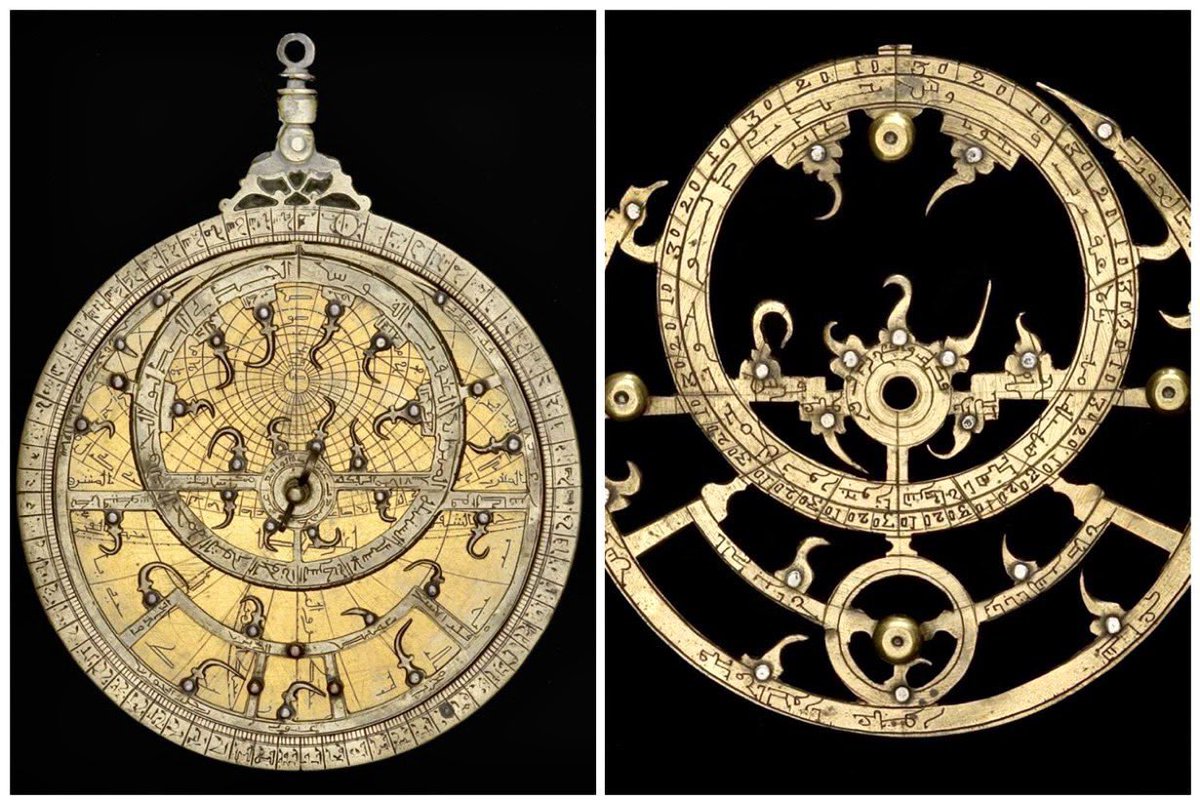Mariam Astrulabi was a pioneering female Muslim scientist & astronomer, born in Syria during the 10th century. She is known for developing Astrolabes, an ancient astronomical computer for solving problems related to time & position of the sun & stars
A thread on Mariam Astrulabi
A thread on Mariam Astrulabi

1/ Mariam al Astrulabi's remarkable contribution to the art of astrolabes has largely been ignored by the world. What she achieved in the 10th century consequently helped several generations of scientists to explore the concept of time and space.
Astrolabe @HSMOxford
Astrolabe @HSMOxford

2/ Astrolabes were beneficial in determining the position of the sun, moon, stars & the planets. They were used in astronomy, astrology & horoscopes. Muslims would specifically use it to find the Qibla, determine prayer times & the initial days of Ramadan and Eid
@sciencemuseum
@sciencemuseum

3/ Astrolabes are complex devices which use several moving parts to turn raw data provided by the user into practical information –they were the computers of their time, used to solve problems relating to the position of the sun, stars, planets & timekeeping
@RMGreenwich
@RMGreenwich

4/ The astrolabe is thought to have originated in Ancient Greece. While the origin may have been Greek, it is generally agreed that the design was perfected in the Islamic world – the name Astrolabe comes from the Arabic version of the Greek term ‘Star holder’
@AgaKhanMuseum
@AgaKhanMuseum

5/ In the 10th century, the Muslim Persian astronomer ‘Abd al-Raḥmān al- Ṣūfī estimated that there were around a thousand possible applications for an astrolabe, ranging from the position of the stars or the direction of Mecca to the height of a building
@metmuseum
@metmuseum

6/ An astrolabe is made up of 4 main pieces:
– the mater or base plate
– the rete shows the fixed stars, the ecliptic & certain naked eye stars
– the plates, each of which is made for a different latitude
– the alidade or rule with sights used for making observations
– the mater or base plate
– the rete shows the fixed stars, the ecliptic & certain naked eye stars
– the plates, each of which is made for a different latitude
– the alidade or rule with sights used for making observations

7/ An indication we find on many Islamic astrolabes, which gives them a religious dimension is the inscriptions. On many Islamic astrolabes we find passages from the Quran, dedications, religious verses & of course the date given according to the Hijra calendar
@MIAQatar
@MIAQatar

8/ Mariam’s interest towards developing Astrolabes grew when she saw her father Al- Ijliyy al-Asturlabi working on them. He was apprenticed to an Astrolabe maker in Baghdad. He shared his knowledge & learning on Astrolabes with Mariam, encouraging her to learn
@britishmuseum
@britishmuseum

9/ Mariam and her father were apprentices of one of the renowned astrolabers in Baghdad called Muḥammad ibn ʿAbd Allāh Nasṭūlus - "Basṭūlus", who is known for making one of the oldest surviving astrolabes, dating back to 927/928. 

10/ Nasṭūlus astrolabes are now on show in the Kuwait Museum of Islamic Art and the Museum of Islamic Art in Cairo
This is the oldest dated astrolabe, made in 928 AD, by Nastulus. Inv. No.LNS 36 M, Dar al-Athar al-Islamiyya, Kuwait.
This is the oldest dated astrolabe, made in 928 AD, by Nastulus. Inv. No.LNS 36 M, Dar al-Athar al-Islamiyya, Kuwait.

11/ Mariam was a brilliant and focused scholar of astronomy who tirelessly worked out the mathematical calculations and precisions. She was dedicated to perfecting transportation and communication using astrolabes
@britishmuseum
@britishmuseum

12/ Designing an astrolabe required Mariam to work with complex mathematical calculations and precision but she gradually mastered the designs. This impressed Sayf Al Dawla, the ruler of the city who found them to be very intricate and innovative
@NtlMuseumsScot
@NtlMuseumsScot

13/ Mariam grew so famous with her work that Sayf Al Dawla decided to employ her in her court in Aleppo. Besides this, she also helped develop navigation and timekeeping techniques.
This astrolabe relates to a group of 6 Western Islamic astrolabes from 1060 @RMGreenwich
This astrolabe relates to a group of 6 Western Islamic astrolabes from 1060 @RMGreenwich

14/ Mariam’s significant contributions in the field of astronomy were recognized when the main-belt asteroid 7060 Al-‘Ijliya, discovered by Henry E. Holt at Palomar Observatory in 1990, was named after her
@HSMOxford
@HSMOxford

15/ Inspired by this science wizard and her fascination for astrolabes, Nigerian American author Nnedi Okorafor wrote a novel ‘Binti’ and wove the central character of the story around Mariam. Her novel received the Nebula Award
@V_and_A
@V_and_A

16/ It is great to know a Muslim, Syrian woman from the past who was passionate about astronomy. She is a role-model for millions of girls & women across the world who also want to make a mark through scientific research and invention
@HSMOxford
@HSMOxford

Discover more about Marium Asrtulabi, Astronomy and the Astrolabe:
baytalfann.com/post/mariam-as…
baytalfann.com/post/mariam-as…
Want to know more about The Art of Astronomy and Islam?
Join us TOMORROW for a fascinating online event where we will explore the rich history and incredible achievements of Islamic astronomers.
June 1, 1.00pm-2.30pm BST, online
If you can’t attend live don’t worry! Everyone… twitter.com/i/web/status/1…
Join us TOMORROW for a fascinating online event where we will explore the rich history and incredible achievements of Islamic astronomers.
June 1, 1.00pm-2.30pm BST, online
If you can’t attend live don’t worry! Everyone… twitter.com/i/web/status/1…

• • •
Missing some Tweet in this thread? You can try to
force a refresh






















